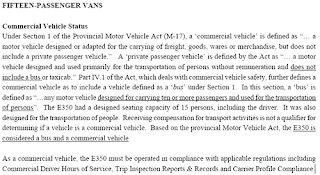According to the Transport Canada Collision Investigation Report which was released last July, 2008, this van was considered a 'bus' used to transport children to off-site extra-curricular activities so it was a commercial vehicle and a bus under the New Brunswick Motor Vehicle Act.

Source: Transport Canada Collision Investigation Report, Page 11
Click here to view Report http://www.cbc.ca/nb/media/pdf/transport_canada_report.pdf )
But after Charles O'Donnel, the Registrar of the New Brunswick Motor Vehicle Branch, testified on Friday, there was some confusion about whether the van our sons were riding in that night was a passenger vehicle or a commercial vehicle.
To us, it is abundantly clear: it was a commercial vehicle, and as such, it falls into a different category under the Motor Vehicle Act with a higher standard for inspections and maintenance, especially tires.
However, some media were certain that witness testimony lent credence to the theory that the van was classifed as a passenger vehicle, which has a considerably lower standard for inspections and maintenance, especially when it comes to tires. So now we have a situation where one major media outlet is calling it a passenger vehicle and another is calling it a commercial vehicle.
We can understand why they would be confused - with all the "expert testimony" it can get very jumbled up and it didn't help that the witnesses from Hatheway Ford, who testified before Mr. O'Donnel, were unclear about the van's status. David Hatheway, co-owner of Hatheway Ford, said it was a "gray area" - a statement which was never clarified by the Crown Prosecutor. This is just another example of the failure of the Coroners Act. If we had standing, our lawyers could cross examine the witnesses. As it is now, they just walk off the stand and everyone is left scratching their heads about what was just said.
The reason we are certain it is a commercial vehicle is because we have been working on this case for 16 months and we know the Motor Vehicle Act as well as the Education Act's Regulations 512 and 513 regarding pupil transportation and vehicle maintenance.
For us, there is no gray. It is black and white. This vehicle was a commercial vehicle and should have been held to a higher standard of Motor Vehicle Inspection by a different mechanic who specializes in commercial vehicle inspections.
The Motor Vehicle Act is very clear about commercial vehicles and Motor Vehicle Inspections. This vehicle should have had an MVI every six months by a qualified commercial vehicle mechanic and if it had, its tires would not have passed even a minimal inspection. As was explained by Greg Sypher of UNB's Transport Group on Wednesday, Commercial Vehicles have different rules for inspection. Using the concept of quarters, he showed the jury and court room that the standard for Commercial Vehicles is higher than that of passenger vehicles.

A number of other rules apply to the operation of commercial vehicles, including the keeping of a log book and limits of on duty time, which the jury has heard numerous times in witness testimony this past week. We base our belief that the van was a commercial vehicle on the evidence given by Mr. Sypher, of UNB's Transport Group, which produced a report on the collision for Transport canada in July, 2008. (Source: page 11, Transport Canada Collision Investigation Report http://www.cbc.ca/nb/media/pdf/transport_canada_report.pdf )
Sypher testified along with Cpl. Annie Nielson, RCMP Accident Reconstructionist, on Wednesday and Thursday, giving a detailed technical interpretation of the conditions leading up the crash.
In the Transport Canada report, it clearly says that the 15 passenger vehicle was a "commercial vehicle".
"Commercial Vehicle Status
Under Section 1 of the Provincial Motor Vehicle Act (M-17), a ‘commercial vehicle’ is defined as “… a motor vehicle designed or adapted for the carrying of freight, goods, wares or merchandise, but does not include a private passenger vehicle.”
A ‘private passenger vehicle’ is defined by the Act as “… a motor vehicle designed and used primarily for the transportation of persons without remuneration and does not include a bus or taxicab.” Part IV.1 of the Act, which deals with commercial vehicle safety, further defines a commercial vehicle as to include a vehicle defined as a ‘bus’ under Section 1. In this section, a ‘bus’ is defined as “…any motor vehicle designed for carrying ten or more passengers and used for the transportation of persons”. The E350 had a designed seating capacity of 15 persons, including the driver. It was also designed for the transportation of people. Receiving compensation for transport activities is not a qualifier for determining if a vehicle is a commercial vehicle. Based on the provincial Motor Vehicle Act, the E350 is considered a bus and a commercial vehicle.
As a commercial vehicle, the E350 must be operated in compliance with applicable regulations including Commercial Driver Hours of Service, Trip Inspection Reports & Records and Carrier Profile Compliance."
The fact that we have to ask for confirmation shows the weakness of the Coroners Act. If this was a real court, there is no way the parents, the media or the jury would have walked out of that room not knowing what type of vehicle our boys were killed in.
We all agree on a few things:
1. The driver was supposed to keep a daily log book and he didn't for at least two years.
2. The driver was supposed to do a pre-trip inspection (he said he did but because he didn't keep a daily log, we have no way of confirming that other than his testimony).
3. The driver was not supposed to accumulate more than 14 hours of on duty time but he did 16 hours.
4. The van was supposed to be inspected every six months and that never happened since it was purchased by Bathurst Van Inc. in 1999.
These are all part of the requirements of Commercial Vehicles under the Motor Vehicle Act.





